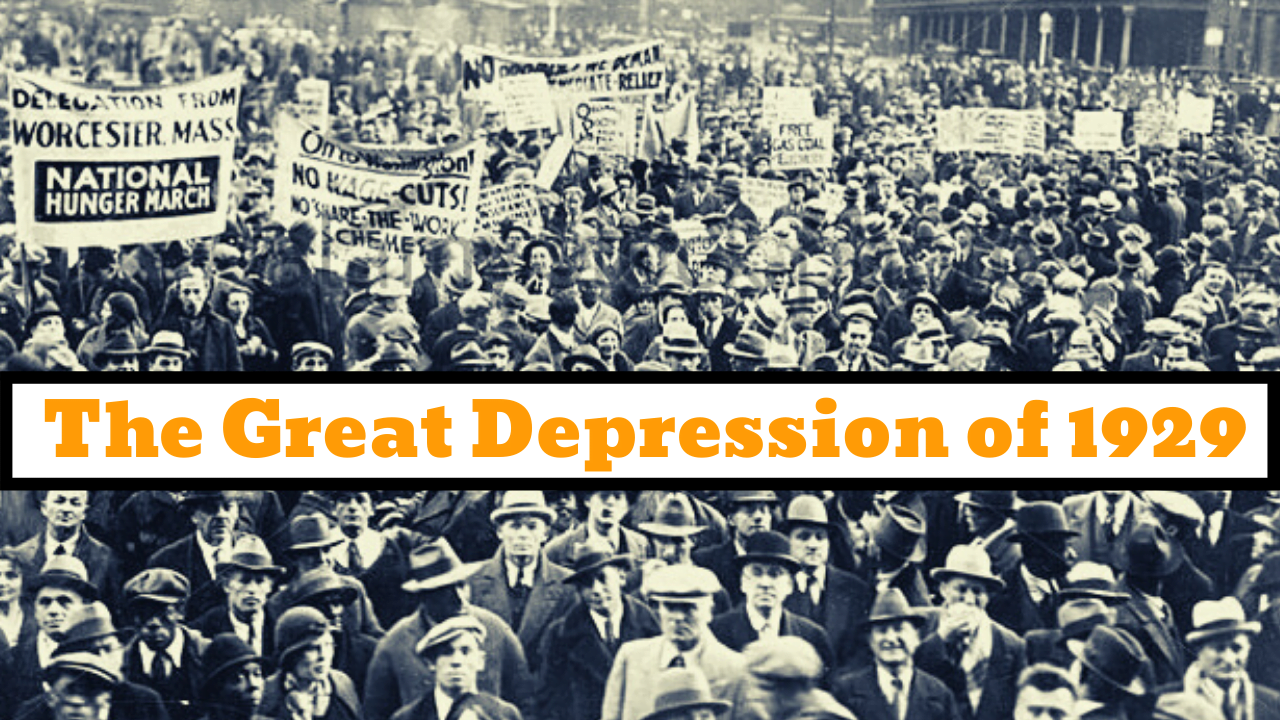Introduction
The Great Depression of 1929 was a worldwide depression which lasted for ten years. The most important event in the U.S. economy was “Black Thursday,” October 24, 1929 when 12.9 million shares of stock were sold in one day. It was triple the usual amount that was spent. Over the next four days, stock prices fell 23% which resulted in the stock market crash of 1929.
The height of the Depression was 1933. By then, unemployment had risen from 3% to 25% of the nation’s workforce. Wages for those who still had jobs fell 42%. The economic output was cut in half, from $103 to $55 billion. That was partly because of deflation Prices fell 10% per year. Panicked government leaders passed the Smoot-Hawley tariff to protect domestic industries and jobs. As a result, the world trade fell 65% as measured in dollars and 25% in the total number of units.
Because of the depression, many farmers lost their farms. In the same time, years of erosion and a drought created the “Dust Bowl” in the Midwest, where no crops could grow. Thousands of these farmers and other unemployed workers looked for work in California. Many ended up living as homeless “hobos” or in shantytowns called “Hoverville’s” named after then-President Herbert Hoover.
- What Caused It
According to Ben Bemanke, the past Chairman of Federal Reserve, the central bank helped create the Depression. It wrongly used monetary policies. Bernanke highlighted several key Fed mistakes:
- The Fed began raising the Fed Funds rate in the spring of 1928. It kept raising it through a recession that began in August 1929. That’s what caused the stock market crash in October 1929.
- When the stock market crashed, investors turned to the currency markets. At that time, dollars were backed by gold held by the U.S. Government. Speculators began selling dollars for gold in September 1931. That created a run on the dollar.
- The Fed raised interest rates again to preserve the value of the dollar. That further restricted the availability of money for businesses. More bankruptcies followed.
- The Fed did not increase the supply of money to combat deflation.
- As investors withdrew all their dollars from banks, the banks failed. That created more panic. The Fed ignored the banks’ plight. It destroyed any remaining consumers’ confidence in banks. Most people withdrew their cash and put it under their mattresses. They further decreased the money supply.
The Great Depression: Social, Psychological and Cultural
Great Depression was one of the major economic events in world history. It affected every sphere of life. The outcomes were such that they changed the face of the world economy. This article deals in detail with the economic, political, social and cultural effects of this crisis and the process of restoration.
- Economic Effects
As it was a major economic phenomenon, it had serious and widespread economic effects.The Depression became a worldwide business downturn of the 1930s that affected most countries. International commerce declined quickly. There was a sharp reduction in tax revenues, profits and personal incomes. It affected both countries that exported raw materials and the industrialized countries. It led to a sharp decrease in world trade as each country tried to protect their own industries and products by raising tariffs on imports. World Trade collapsed with trade in 1939 still below the 1929 level.
2. Employee Distress
Wages were scaled down to 20 percent, whereas 25 percent of the workforce was left unemployed. This led to decrease in the standard of living pushing the economy further into the depth of the Depression.
- Breakdown of the Financial Machinery
Thousands of investors lost large sums of money and several were wiped out, losing everything. Banks, stores, and factories were closed and left millions of people jobless, penniless and homeless. In 1929, 659 public sector banks were shut and by the end of 1931 this number rose to 2294. Many people came to depend on the government or charities to provide them with food.
- Effect on Agriculture
Due to lack of subsidies and loans, farmers were unable to support mass produce leading to under-capacity output. Textile farming faced the major blow. The period served as a precursor to one of the worst droughts in modern American history that struck the Great Plains in 1934.
- Political Effects
The Depression had profound political effects. In countries such as Germany and Japan, reaction to the Depression brought about the rise to power of militarist governments who adopted the aggressive foreign policies that led to the Second World War. In Germany, weak economic conditions led to the rise to the power of Adolf Hitler. Germany suffered greatly because of the huge debt the country was burdened by following World War I.
The Japanese invaded China and developed mines and industries in Manchuria. Japan thought that this economic growth would relieve the Depression.
In countries such as the United States and Britain, the government intervened which ultimately resulted in the creation of welfare systems. Franklin D. Roosevelt became the United States President in 1933.
He promised a “New Deal” under which the government would intervene to reduce unemployment by work-creation schemes such as painting of the post offices and street cleaning. Both agriculture and industry were supported by policies to limit output and increase prices.
- Social and Cultural Effects
This economic catastrophe hit the humans in the worst way possible. They were surrounded by miseries from all sides.Due to failure of the financial machinery, masses’ faith over the economic system shattered. This resulted in a sudden rise in the crime rate. Theft, burglary and felony became common occurrences. With no income and several mouths to feed, workers were pushed to commit suicides. Malnutrition was one of the severe outcomes of the Depression.
- Rehabilitation Process
The Great Depression ended as nations augmented their production of war materials at the beginning of World War II. This increased production provided jobs and put considerable amounts of money back into circulation. In an attempt to revive the economy, governments all over the world actively participated in the regulation process especially of the financial markets. United States constituted the Social Security Act (1935) as a response to the hardships of 1930s. It included unemployment compensation and old age and survivors’ insurance scheme. With this, several other acts like the Security Exchange Act of 1933, the Glass-Steagall Act, Emergency Relief and Construction Act, etc., were introduced as corrective measures.
In Germany, Hitler developed a massive work-creation scheme that had largely removed unemployment by 1936. Rearmament, paid for by government borrowing, started in a major way. In order to control inflation, consumption was restricted by rationing and trade controls. By 1939 the Germans’ Gross National Product was 51% higher than in 1929 which were mainly due to the manufacture of machinery and armaments.
- Remedy
In 1932, Franklin D. Roosevelt was elected President.
He promised to create federal government programs to end the Great Depression. Within 100 days, the New Deal was signed into law. It created 42 new agencies designed to create jobs, allow unionization, and provide unemployment insurance. They help safeguard the economy and prevent another depression
Many argue that World War II, not the New Deal, ended the Depression. However, if FDR had spent as much on the New Deal as he did during the War, it would have ended the Depression. From 1932, when the New Deal was launched, to 1941, when Japan attacked Pearl Harbor, spending only increased the debt by $3 billion. In 1942, defense spending added $23 billion to the debt, and $64 billion in 1943.
If that much had been spent on the New Deal, it would have been enough to end the Depression.
- After effects Measures
- Effects of New Deal: Combating Great Depression
- Strengthened the American Economy.
- Restored Confidence among people.
- Increased production and thus industrial prosperity.
- By 1940, there was normal economic activity in the USA.
The New Deal expanded the regulatory power of the federal government and the government’s role in the economy. It focused new attention on the plight of workers, women, racial minorities, children, and other groups.
However, many Keynesian economists believe that it was actually the big government spending during World War II which ended the Great Depression. The military guns, tanks, ships, and planes were mass produced. Unemployment started to decline at the start of World War II.
Though the Allies and the Axis Powers had been at war since 1939, the United States remained neutral until the Japanese attacked Pearl Harbor on December 7, 1941.
World War II ushered in numerous social changes, including more civil liberties and the movement of women into previously male-only jobs.




